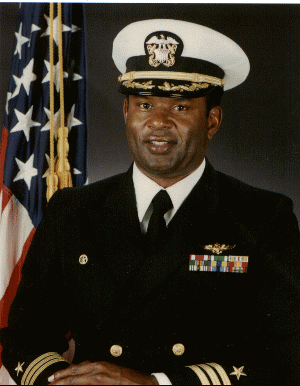Donnie Cochran facts for kids
Quick facts for kids
Donnie L. Cochran
|
|
|---|---|

Official Navy photo of Commander Donnie Cochran, USN
|
|
| Born | July 6, 1954 Pelham, Georgia, U.S. |
| Allegiance | |
| Service/ |
|
| Years of service | 1976–2000 |
| Rank | Captain (retired) |
Donnie L. Cochran is a brave former United States Navy pilot. He made history as the first African-American pilot chosen for the famous Blue Angels flight team in 1986. Later, in 1994, he became the first African-American to lead the Blue Angels. In 2022, he was honored by being added to the Georgia Aviation Hall of Fame.
Contents
Early Life and Education
Donnie L. Cochran was born on July 6, 1954, on a farm in Pelham, Georgia. He went to Savannah State College and graduated in June 1976. He earned a degree in civil engineering technology. At the same time, he joined the United States Navy as an officer.
Donnie Cochran finished flight school and earned his Navy "Wings of Gold" in 1978. This meant he was officially a Navy pilot! He first learned to fly jet planes like the T-2C Buckeye and the TA-4J Skyhawk.
Because he was so good at landing planes on aircraft carriers, he was chosen to fly the RF-8G Crusader. He was sent to a squadron called VFP-63 in San Diego, California. He flew the RF-8G on his first mission aboard the USS Nimitz (CVN-68) aircraft carrier. They traveled to the Mediterranean Sea and the Indian Ocean. During this trip, his ship was sent to the Indian Ocean to help with a situation. He even flew to another ship, the USS Coral Sea (CV-43). By the end of this nine-month journey, he had traveled all the way around the world!
After flying the Crusader, the Navy started using newer planes. So, Cochran learned to fly the F-14A Tomcat. He then joined Fighter Squadron 213 (VF-213). He went on two more missions aboard the USS Enterprise (CVN-65). By this time, he had flown over 2,000 hours and landed on aircraft carriers 469 times! Next, he became an instructor pilot, teaching others how to fly the F-14.
Joining the Blue Angels
In 1985, Captain Cochran applied to be a pilot for the Blue Angels. He was chosen, becoming the very first African-American pilot to fly with this amazing team! He flew with them for three seasons, from 1986 to 1988.
In 1986, he flew the number 3 jet, which was an A-4F Skyhawk. That same year, the Navy announced that the Blue Angels would switch to a new, faster plane: the F/A-18 Hornet. To make sure the team could safely learn the new jets, the main pilots stayed in their positions for an extra year. This meant Captain Cochran flew the number 3 jet again in 1987. In 1988, he moved to the number 4 jet. During his time as a Blue Angels pilot, he flew over 1,500 hours and performed in more than 240 airshows!
Leading the Blue Angels
After his first time with the Blue Angels, Captain Cochran continued his Navy career. He flew with the Bounty Hunters of VF-2 and went on another mission aboard the USS Ranger (CV-61). He also attended the Air War College and earned a master's degree.
He then became the executive officer (XO) of Fighter Squadron 1 (VF-1). They flew missions over Southern Iraq to help keep the peace. Captain Cochran flew over 24 missions and earned an Air Medal for his service. Later, he became the commanding officer (CO) of VF-1.
In November 1994, Captain Cochran made history again. He became the first African-American commanding officer and flight leader of the Blue Angels! This special ceremony took place at the National Naval Aviation Museum in Naval Air Station Pensacola, Florida. He led the team for 16 months.
In May 1996, Captain Cochran decided to step down as flight leader. He did this to make sure the team and the audience stayed as safe as possible. He believes that strong leadership and teamwork are very important. He often shares lessons about how important it is for team members to respect each other and for leaders to hold everyone accountable.
After the Blue Angels
After leaving the Blue Angels, Captain Cochran continued to serve the Navy. From 1996 to 1999, he led the Naval Reserve Officer Training Corps Unit (NROTC) at Florida A & M University. He helped train over 100 future Navy and United States Marine Corps officers.
His last job was as the deputy commander of the United States Navy Recruiting Command. He helped lead over 7,000 people across the country and overseas. Captain Cochran retired from the U.S. Navy after more than 24 years of amazing leadership and flying experience.
Honors and Recognition
On May 10, 1991, Savannah State University honored Donnie Cochran. They placed an A-4 jet, painted in the Blue Angels' blue and gold colors, on their campus. A plaque was added to honor him as the first Black Naval Aviator to fly with the Blue Angels. Later, a second plaque was added to honor him as the first Black Naval Aviator to command the Blue Angels.
In August 2015, Georgia's Governor Nathan Deal honored Donnie Cochran by renaming the old Pelham's Detention Center to the Donnie Cochran Community Complex. In December 2016, he was inducted into the Georgia Military Veteran Hall of Fame.
Education
Donnie Cochran earned his civil engineering degree from Savannah State College (now Savannah State University) in 1976. He was part of the NROTC program there. He also studied at the Air War College and earned a master's degree in human resource management from Troy State University.
Images for kids


